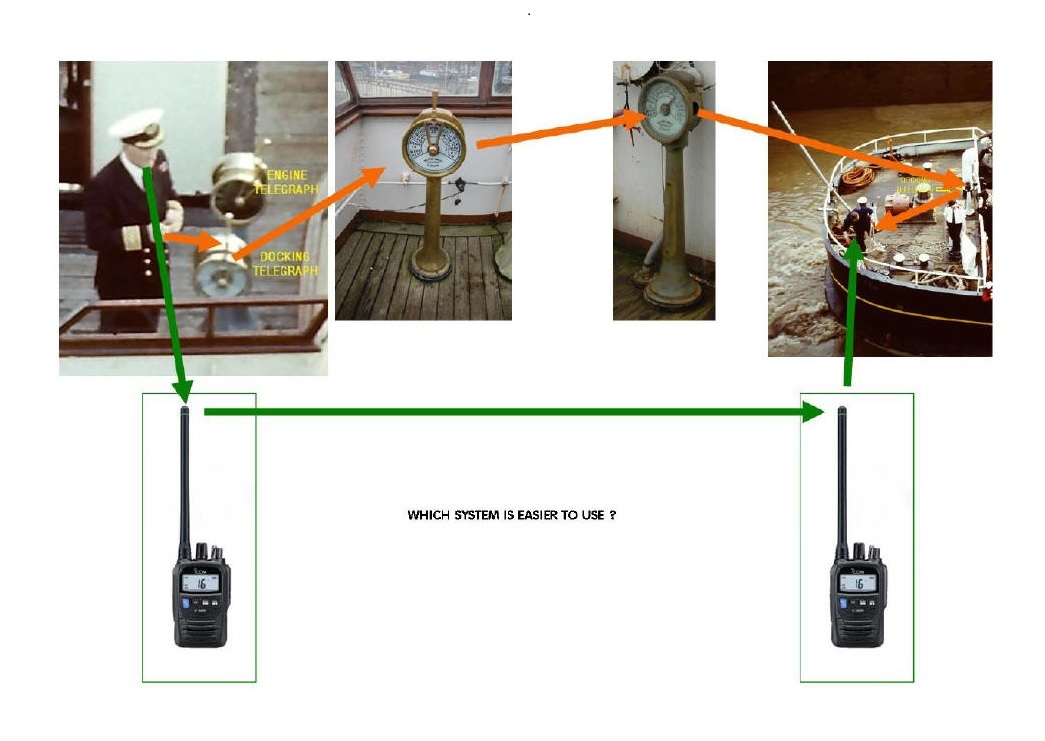Ships use ropes to
hold themselves against a pier and dock walls. The
ropes are secured to bollards , steel posts with a wide top bolted or
concreted into the structure of the mooring. These
have to be extremely strong as they not only have to hold the ship steady but
have to keep it in place when the wind is blowing or if there is a strong
current. The ropes also have to stop the ship moving when it arrives and there
can be a huge force exerted as the inertia of the ship - this is its weight
multiplied by the speed it is travelling - this force must be taken up by the
rope and the mooring bollard.
When the 'haul in' signal is given on the
docking telegraph ( see the section below for
details about this signalling system ) the operator pulls on the slack end of
the rope that is wound loosely round the drum of the winch. This tightens the rope slightly on the drum
and it grips the surface. The amount of tension on the free end of the
rope is multiplied several hundred times and the resulting force is enough to
move the entire ship, pulling it into the correct position. The Captain signals
with the docking telegraph or a hand held radio to tell the winch operator what to do and by heaving
in and paying out the ropes at each end of the ship, she can be positioned in
exactly the right place regardless of the wind and waves. If the ship is to be
moored for any length of time or in bad weather, additional ropes are run ashore
to provide additional security.
A skilled crewman can use just a light tension on the
free end of the rope to exert a huge force - so much so that it can
even break the rope!
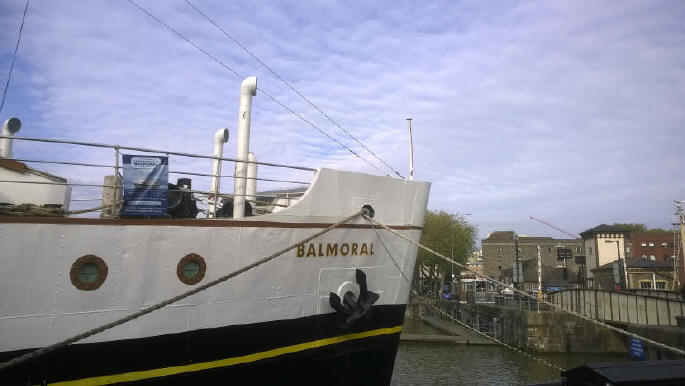
You will see that below the hawsehole
where the rope enters the ship which is the rounded hole in the side
through which the ropes leave the ship, is an anchor. Unlike a car or bus,
a ship has no parking brake and will only stop if it runs aground or is moored to a
solid object ! To stop at sea, it is necessary to lower an anchor. This
is sometimes called 'Dropping the pick' or 'Throwing out the Hook'. The anchor is heavy
steel weight with prongs ( called flutes ) on a very long chain. It falls to the sea
bed and is weighted down by the chain so that it falls onto its side and the flutes dig
into the sea bed and prevent it moving. The ship then pays out a long
length of chain so that the weight keeps the anchor almost flat on the bottom,
and this holds the ship in one place. She will actually swing round the
anchor as the tide and wind affect her and must be well clear of any
obstructions or other ships, but in very simple terms, the anchor is lowered and
the ship can then stop. The anchor holds the chain in position but the
heavy chain holds the ship.
It is easy to lower the anchor, but very difficult
to get it up as you have to pull all the chain up first and even Balmoral's
anchors which are quite small, weigh around 400 kgs each and the chain much more
than that. This is also a
job for the winch. The rope drums can be disconnected and the chain
lifters driven by the winch motor. These have 'snugs' into which the links
of the chain fit so that it grips and the free end of the chain is fed into a
chain locker below the deck.
There is an anchor on
each side of the bow. When the anchor is dropped it is 'let go' and falls
under its own weight. This makes a tremendous noise as it falls, a huge
splash and then it slows up as it lands on the sea bed. Once the chain
speed has slowed down, the anchor is allowed some more chain to 'set' in
position and then the ship may be reversed very gently to make sure the anchor
is holding. The two 'T' handles beside the motor operate a brake band to lock
the winch mechanism and when at sea the chain is locked in place using 'bits' and
in this photograph, also a steel cable .
A major problem for
ships is if the anchor is 'fouled' and catches on an obstruction or cable. As
you can't see the bottom there is no way of knowing what is down there.
The chart will show the type of bottom, rock, mud, sand etc but not the exact
conditions at a particular point.
In some cases the winch can't pull the anchor up if it is trapped by wreckage or
a rock and this might endanger the
ship, so the chain has to have a line tied to it and is then cut. Anchors
are expensive, so it is usually necessary to hire a diver to go down and free
the anchor and then retrieve it later. All this takes a lot of time and
money and also a reason why the ship has two anchors - in case one is lost !
Balmoral has lost several anchors at Lundy Island over the years but they have
all been recovered by diving enthusiasts who attach a rope and float to the
chain so that it can be picked up and pulled aboard the ship. However
cutting the cable is the last resort and only done after a major fuss trying to
free the anchor by moving the ship about and pulling very hard with the winch !
Even worse is if the anchor happens to land on a telecoms cable or power line.
These should be protected and are all well marked on marine charts but it does
happen and occasionally causes havoc by cutting power or communication to
islands and remote areas - and a very big bill for the ships owners !
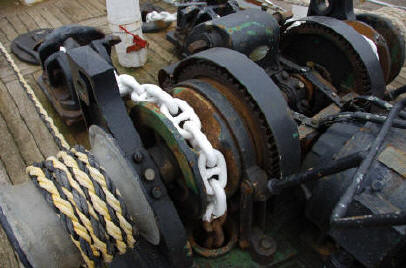
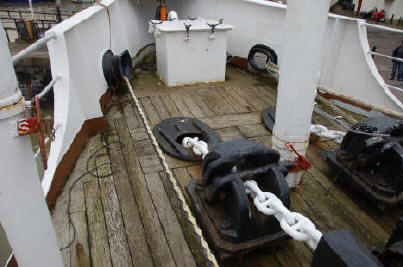
At the stern of the ship is a smaller capstan type
winch with a vertical drum. This is only used for rope handling and does not
have a facility for handling chain, although there is a small anchor stored on
the rear ( poop ) deck for use in an emergency. The photograph below was taken in
1975 before Balmoral had her car deck enclosed - at this time she was still
registered in Southampton. You can see the capstan drum and winch motor
and two members of the P & A Campbell crew together with the hawseholes and
fairleads used for running out cables.
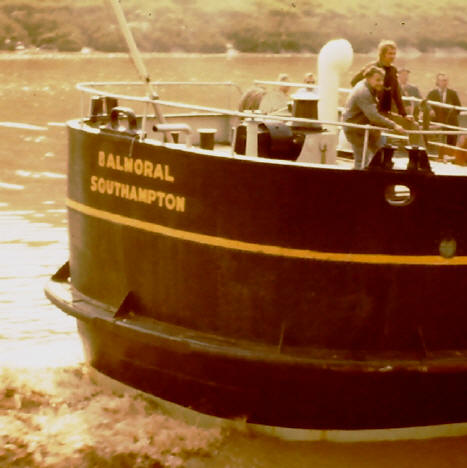
DOCKING
TELEGRAPHS
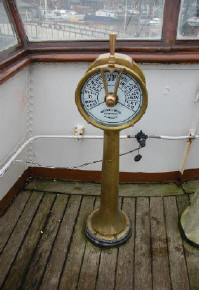
.JPG)
.JPG)
Before the days of hand held radios, it was necessary for the crew
working the mooring ropes to be told what to do, and when to do it. The ropes have to be tightened and released as necessary to
manoeuvre the
ship alongside a wall or jetty or to help turn her round in a confined
harbour. This can be a tricky operation and it is vital to get
the ship in exactly the right place - otherwise the gangways won't fit the
space made for them on the pier head and passengers can't get on or off!
In the Bristol Channel with fast tides and strong currents this can be a
skilled operation. Moving a 600 ton ship in a fast tide with a wind blowing
takes a lot of power- and that has to be controlled accurately. The engines
can do some of the work, but the final job of securing the ship in the right
place and holding her there against wind, waves and current is the job of
the ropes.
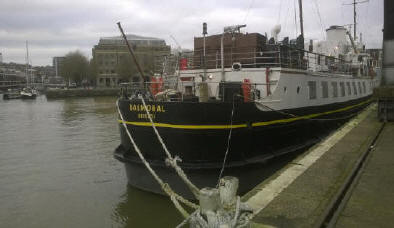
.jpg)
As you can see from the
photographs, the Captain can't see the stern
of the ship where the mooring lines are handled and
certainly can't shout that far, but he has to be able to tell the
crew there what to do. The ship is equipped with a set of 'docking
telegraphs' similar to the engine room telegraph but without the
reply facility so that the men on the deck at each end of the ship can
moor the ship in the right place. Thiss is the
purpose of the second telegraph binnacle on the bridge.
There is no way for the crew to tell the bridge of something is wrong and
the directions only go one way. Thus if a rope breaks or gets jammed,
the Captain won't know unless someone runs the length of the ship to tell
him. This was how commands were passed before cheap and lightweight
hand held radios. The system was all mechanical relying on chains,
wires and linkages. It was reliable and as soon as the captain gave a
command it was seen by the men on the ropes, but there was no way they could
respond. Using a hand held radio allows a two way flow of information
and a much faster and more accurate result.
These days the docking telegraphs are not installed but are fully restored
and will eventually be put back in their rightful place. However
handheld radios make the job easier and faster.
